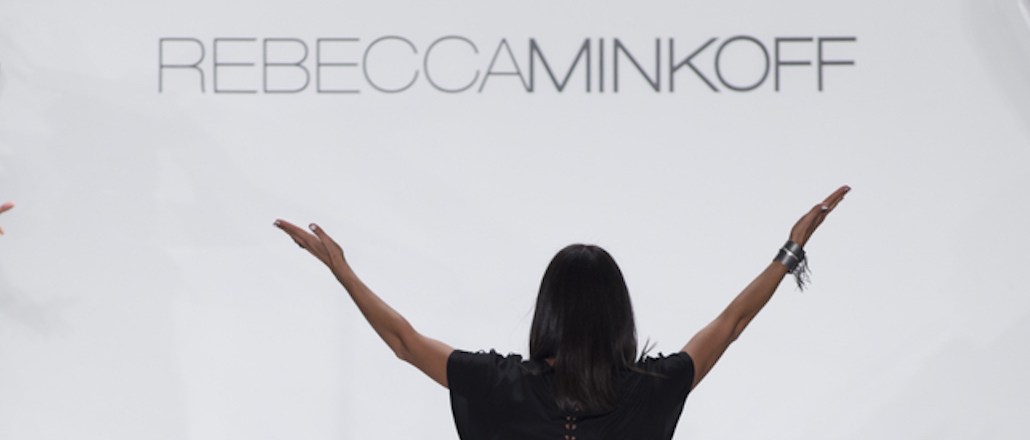How tech in Rebecca Minkoff’s fitting rooms tripled expected clothing sales

Nearly a year after its opening, Rebecca Minkoff’s flagship store in New York City’s Soho neighborhood is a hotbed of consumer data. The “connected store,” which is the first of three to open in the U.S., has given the designer brand some key takeaways: The team can find out which items are taken into the fitting room, what’s being purchased or left behind, and what new directions it should be heading in as an emerging name in retail.
The Soho store, which spans 2,000 square feet, opened last November with interactive screens both on the main floor and in the fitting rooms. On the floor, shoppers can tap the screens — which look like mirrors when not activated — to flip through look books curated by Rebecca Minkoff, or order a free coffee or glass of champagne. To place a drink order, shoppers must enter a phone number, which will then be used during their trip as a way for the store associates to communicate with them about drink orders and fitting room status, as well as let shoppers save a list of items they tried on for later.
In the fitting room, the technology — powered by eBay — again overlays the mirror; no cameras are involved in the tech integration. RFID tags recognize each item brought in, and shoppers can pull up product screens that show the item styled with different looks, as well as other available sizes and colors, much like you would find when shopping online.
According to Uri Minkoff, the brand’s CEO and co-founder (and Rebecca’s brother), the enhanced fitting rooms have both increased customers’ time spent in stores and boosted clothing sales since the store opened (Rebecca Minkoff items are also available to shop wholesale in department stores).
“We’re predominantly known for our handbags,” said Minkoff. “Since opening the store, we’ve seen a huge sales boost in clothing. We’ve made triple the amount of clothing sales than we thought we would.” Minkoff added that 30 percent of customers who try things on request, via the fitting room’s touch screen, additional items to be brought in by an associate.
“That’s substantial,” said Minkoff. “Trying something on signifies intent, and the customer may not have been thinking about buying a dress, but they see it suggested on the screen and know to ask for it.”
Minkoff said that knowing how customers are responding to certain items has helped them change the direction of their collections. Customers were mixing and matching certain items in the fitting rooms, leading the brand to incorporate more date night and weekend wear into its mostly business attire collection.
Rebecca Minkoff joins brands like Kate Spade that have partnered with eBay, Inc., in its efforts to infuse retail stores with technology, providing an in-store experience that incorporates e-commerce benefits. According to David Geisinger, eBay’s head of retail and mobile innovation, engagement with the technology in Minkoff stores has been greater than expected.
“Engagement is on the customer’s terms, which I think is key,” said Geisinger. “It’s not intrusive.”
In Soho, store manager Bree Ryan said that they aim for customers’ engagement with the screen to hit as close to 100 percent as possible. She adds that Rebecca Minkoff’s customers skew millennial, and that those customers don’t need much guidance using the screens. Older customers, however, need more of a walk through.

In the next month or so, frequent shoppers will be able to let associates know that they’d like to be identifiable by their phone number, according to Minkoff. Associates, all equipped with smartphones, will get a nudge with their shopping history — a go-to drink order and past fitting-room items — when those customers enter the store.
“Customers love the technology now because they’re feeling more confident in the fitting room,” he said. “Next, they’ll be able to get an unbelievable level of customer service, if they choose to announce themselves when they arrive in store.” That “announcement” will come in the form of an opt-in beacon service, available in the forthcoming Rebecca Minkoff app.
According to eBay’s Geisinger, the highly curated model seen at Rebecca Minkoff wouldn’t work at larger stores, like Zara, but that doesn’t mean the technology isn’t scalable; it would simply look different. Instead of a mirror overlay, a separate screen in the fitting rooms would be installed to bring up different sizes, colors, recommended items, and page associates, integrations that Geisinger said are coming up soon.
“People have focused on organizing stores around products, but our version is organizing stores around customers,” said Geisinger. “Customers are demanding more experience, more engagement, and the feeling and the activity of shopping is more important than it used to be.”
Image via FashionStock.com/Shutterstock
More in Marketing

The anatomy of an agency chief client officer
Several major agencies have moved to appoint chief client officers to their top cohorts lately.

How marketers rank this year’s generative AI image, video tools
Digiday’s 2025 agency generative AI report card explores the winners and losers of the generative AI landscape.

In memoriam: Brands we lost in 2025
Digiday Media staff rounded up some of the most notable brand names we lost in 2025, like Joann and Rite Aid.








